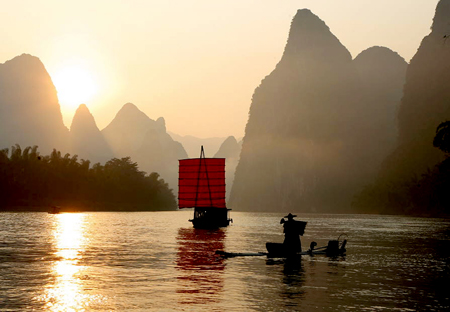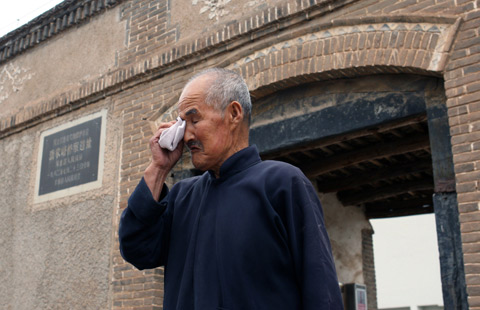Guilin never ceases to amaze
(Shanghai Daily) Updated: 2014-10-10 17:05The most enchanting sights in China are said to be Shanghai at night, Beijing in autumn, Chongqing in fog and Guilin in the rain. I headed to Guilin, which means forest of sweet osmanthus, two weeks ago and was awed by the rain and mist-shrouded peaks in this world-famous site in the Guangxi Zhuang autonomous region.
|
 Photo taken on August 2, 2009 shows the sunrise in Lijiang River in Guilin city, southwest China's Guangxi Zhuang autonomous region. The red sail boat used to be the freight vessel before the 1970s, now it has become a special scenery to attract tourists. [Xinhua File Photo/Wang Zhongkang]
|
I could appreciate the sentiments of Wang Zhengong, a poet in the Song Dynasty (960-1279) who carved on the Solitary Beauty Peak: "No landscape on Earth equals Guilin in beauty."
The flight from Shanghai takes around two and a half hours and when arriving I immediately smelled the sweet osmanthus trees that grow everywhere in the city. The red lanterns from the Chinese Lunar New Year are still hanging in the trees.
The famous boat cruise on the winding Lijiang River passes the many karst mountains and peaks, some with bizarre shapes that resemble an elephant sipping water, a walking camel and an old man lost in thought.
The rain and fog above the river lend an air of mystery. When the river takes a big turn at Xingping Old Town, I saw the familiar and heart-stopping beauty that is engraved on the 20-yuan Chinese bank notes. Fishermen float by on bamboo rafts with their "leashed" cormorants that dive for fish. Every morning they sell fish, shrimp and crabs to cruise boats.
In addition to natural scenery, the slow-paced city is rich in history and culture. The Sun and Moon pagodas on Banyan Lake reflect a balance of yin and yang, two fundamentals of Chinese philosophy.
The nine-story shining Sun Pagoda is covered in copper and is the world's tallest copper pagoda. The silvery Moon Pagoda is a seven-story tower of glass. They complement each other and suggest that the interaction of yin and yang gives rise to everything in the universe.
Royal compound
The Jingjiang Prince's Palace is considered the most auspicious place in Guilin. Built from 1372 to 1392 in the Ming Dynasty (1368-1644), the royal complex was the official residence of Zhu Shouqian, great-nephew of Zhu Yuanzhang, the first emperor of the Ming Dynasty.
In the 257 years from construction to the end of the Ming Dynasty, 14 princes from 12 generations lived there. It was also the base camp for revolutionary and political leader Sun Yat-sen during the Northern Expedition in 1921.
Xiang yun or "auspicious clouds" are carved on the entrance gate and delicately carved balustrades and marble steps are well preserved.
The building satisfies the basic requirements of feng shui - it is south of a hill (Solitary Beauty Peak) and north of a river (Lijiang River). In the garden, tree branches take the shape of a dragon's claw. On the southern stone face of the mountain is a giant inscription of the Chinese character shou (longevity) written by the Qing Dynasty (1644-1911) Empress Dowager Cixi.
Inside Peace Cave at the foot of the peak, the wall is carved with the images of 60 Chinese gods of the zodiac. According to the zodiac, 60 gods take their turns to be Tai Sui (Grand Duke of Jupiter) every year and each has characteristics that astrologers compare with people's zodiac animals.
In the Qing Dynasty, some pavilions were converted into an Examination House where scholars took the ancient imperial exams that could ensure their futures. Visitors took their own simple exams about city facts, filling in the answer sheet with an ink brush; the best performers received local delicacies.
Around 65 kilometers southeast of Guilin, Yangshuo is 2,000-year-old town famous for its breathtaking views of hills and rivers - and bustling bar streets.
A bamboo raft ride on the picturesque Yulong River, a tributary of the Lijiang River, takes visitors past peaceful fields and terraced mountains. The river has a series of small dams and there's a bit of a bump and adventure as the boatman uses the pole to move downstream.
Along the way are many waterside cafes and beer houses offering visitors a chance to rest and enjoy roast fish, chicken and snacks. During peak holidays, the river and the cafes are crowded and noisy; there are hundreds of rafts. A bicycle ride along the river is more peaceful.
Lively West Street lies in the center of Yangshuo, a few kilometers from the Yulong River, and the 1,400-year-old road is packed with tourists who enjoy its East-West ambience.
It's also known as "Foreigners' Street." There are a variety of cafes, restaurants, bars and little shops selling locally made souvenirs. Every year around 100,000 foreigner visit Yangshuo, some for pleasure, some for business.
Bicycles and motorbikes are for rent. Nearby are strawberry fields where visitors can pick their own fruit. Gear for camping and rock climbing is sold and rented.
A dozen kilometers away from Yangshuo is the karst Silver Cave, which is famous for its stalactites forming spectacular curtains, flowers and pillars. They are dramatized by colorful spotlights. It's awesome and mysterious.
There are still other nearby attractions, such as magnificent rice terraces in the mountainous village of the Longji minority.
- Beijing given central funds to curb pollution
- HK police vow minimum force to remove protest road barriers
- Two expelled over street monkey show in C China
- Chinese VP calls for closer China-Russia youth exchanges
- Premier Li vows to safeguard WWII victory with Russia
- Beijing subway fares likely to double
- Policewoman killed in Xinjiang
- HK chief says reform must not abandon law
- China moves to boost
court transparency - Uygur kebab king takes a poke at poverty in SW China







